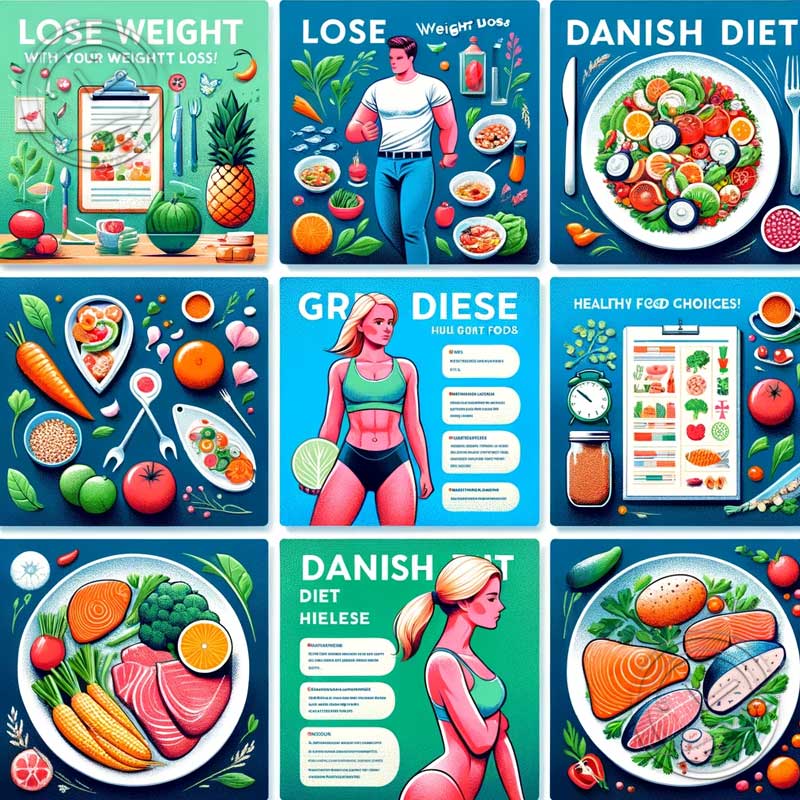Danish Diet for Weight Loss
The Danish Diet is a popular weight loss diet that is based on the traditional eating habits of the people of Denmark. It is a low-calorie, high-protein diet that is said to be effective for losing weight and improving overall health.
The Danish Diet is based on the principle of eating whole, unprocessed foods. It emphasizes fruits, vegetables, and lean protein, and limits the intake of processed foods, sugary drinks, and unhealthy fats.
The Danish Diet is also a relatively flexible diet, and there is no set meal plan that you must follow. You can eat whatever foods you like, as long as they are healthy and within your calorie limits.
The Danish Diet is a safe and effective way to lose weight and improve your health. It is a sustainable diet that you can follow for the long term.
Benefits
The Danish Diet is a healthy and balanced diet that can help you lose weight and improve your overall health. Here are some of the benefits of the Danish Diet for weight loss:
- It is high in fruits, vegetables, and whole grains, which are all essential for weight loss.
- It is low in saturated fat and cholesterol, which can help to reduce your risk of heart disease and stroke.
- It is rich in fiber, which can help you feel full and satisfied after eating, which can lead to reduced calorie intake.
- It is low in processed foods, which are often high in calories and unhealthy fats.
- It is a flexible diet that can be customized to fit your individual needs and preferences.
If you are looking for a healthy and effective way to lose weight, the Danish Diet is a great option. It is a well-rounded diet that can help you lose weight and improve your overall health.
Mediterranean Diet and Cancer Prevention
Unlock the power of the Mediterranean diet in your fight against cancer. Discover a flavorful journey through sun-drenched regions, packed…
How to Follow the Danish Diet
The Danish Diet is a healthy and sustainable way to lose weight. It is based on eating whole, unprocessed foods that are rich in nutrients. The diet also emphasizes eating plenty of fruits, vegetables, and whole grains.
Here are some tips for following the Danish Diet:
- Eat plenty of fruits and vegetables.
- Choose whole grains over refined grains.
- Limit your intake of processed foods and sugary drinks.
- Eat plenty of protein.
- Get regular exercise.
By following these tips, you can lose weight and improve your overall health.
Here is a sample meal plan for the Danish Diet:
- Breakfast: Oatmeal with fruit and nuts
- Lunch: Salad with grilled chicken or fish
- Dinner: Salmon with roasted vegetables
You can also find more recipes and meal plans for the Danish Diet online.
Foods to Eat
The Danish Diet is a healthy diet that is based on whole foods. It is rich in fruits, vegetables, whole grains, and lean protein. Some of the specific foods that are recommended on the Danish Diet include:
- Fruits: All fruits are allowed on the Danish Diet, but some of the best choices include apples, oranges, bananas, berries, and grapes.
- Vegetables: All vegetables are allowed on the Danish Diet, but some of the best choices include leafy greens, broccoli, cauliflower, carrots, and tomatoes.
- Whole grains: Whole grains are a good source of fiber, which can help you feel full and satisfied. Some of the best choices include whole-wheat bread, brown rice, quinoa, and oatmeal.
- Lean protein: Lean protein is an important part of any healthy diet. Some of the best choices include fish, chicken, turkey, tofu, and beans.
In addition to these specific foods, the Danish Diet also encourages you to eat plenty of healthy fats, such as olive oil, avocado oil, and nuts. It also encourages you to drink plenty of water and unsweetened tea.
By following the Danish Diet, you can enjoy a healthy diet that is both delicious and satisfying. You can also lose weight and improve your overall health.
Mediterranean Diet for Crohn's and Colitis: Does It Help?
Discover the transformative power of the Mediterranean diet for Crohn's and Colitis sufferers. With its rich array of fruits, vegetables,…
Foods to Avoid
The Danish Diet is a healthy and balanced diet that can help you lose weight and improve your overall health. However, there are some foods that you should avoid on this diet in order to get the most out of it.
- Sugary drinks: Sugary drinks are a major source of empty calories, and they can sabotage your weight loss goals. Avoid sugary drinks like soda, juice, and sweetened tea.
- Processed foods: Processed foods are often high in unhealthy ingredients like added sugar, unhealthy fats, and sodium. Avoid processed foods like chips, cookies, and fast food.
- White bread and pasta: White bread and pasta are made from refined flour, which is a high-glycemic carbohydrate that can cause blood sugar spikes. Avoid white bread and pasta and opt for whole-wheat bread and pasta instead.
- Fried foods: Fried foods are high in unhealthy fats, which can increase your risk of heart disease and other health problems. Avoid fried foods like french fries, chicken nuggets, and fried fish.
- Red meat: Red meat is a good source of protein, but it is also high in saturated fat. Limit your intake of red meat to no more than three times per week.
- Processed meats: Processed meats like bacon, ham, and sausage are high in unhealthy fats and sodium. Avoid processed meats as much as possible.
- Dairy products: Dairy products can be a healthy part of a diet, but they can also be high in saturated fat. If you are trying to lose weight, limit your intake of dairy products to low-fat or nonfat options.
- Alcohol: Alcohol is a calorie-dense beverage that can sabotage your weight loss goals. If you are trying to lose weight, limit your alcohol intake to no more than one drink per day for women and two drinks per day for men.
By avoiding these foods, you can improve your chances of losing weight and improving your overall health on the Danish Diet.
Tips for Following
Here are some tips for following the Danish Diet:
- Start slowly. Don’t try to change everything all at once. Start by making small changes to your diet, such as adding more fruits and vegetables or cutting out sugary drinks.
- Be realistic. The Danish Diet is not a quick fix. It takes time and effort to lose weight and keep it off. Don’t get discouraged if you don’t see results immediately. Just keep at it and you will eventually reach your goals.
- Find support. Having support from friends, family, or a weight loss group can help you stay motivated on the Danish Diet.
- Make it a lifestyle change. The Danish Diet is not a fad diet. It’s a way of eating that you can stick to for the long term. If you make it a lifestyle change, you’ll be more likely to keep the weight off.
Here are some additional tips that may help you follow the Danish Diet:
- Cook at home more often. This will give you more control over the ingredients in your food and help you stick to the Danish Diet.
- Read food labels carefully. This will help you make informed choices about the foods you eat.
- Be mindful of your eating habits. Pay attention to how you feel when you eat certain foods. This will help you make healthier choices.
- Don’t be afraid to ask for help. If you’re struggling to follow the Danish Diet, don’t be afraid to reach out for help from a doctor or dietitian.
DASH Diet and High Blood Pressure – Hypertension
Discover the life-changing DASH Diet, a revolutionary approach to conquering hypertension, the silent threat that affects millions worldwide. This meticulously…
Common Mistakes
Here are some common mistakes that people make when following the Danish Diet:
- Not eating enough protein.
- Not eating enough fruits and vegetables.
- Eating too much processed food.
- Not getting enough exercise.
- Giving up too soon.
If you avoid these mistakes, you’ll be more likely to achieve success with the Danish Diet.

How Long Does It Take to Lose Weight?
There is no one-size-fits-all answer to this question, as the amount of weight you lose on the Danish Diet will vary depending on your individual factors, such as your starting weight, activity level, and metabolism. However, some studies have shown that people who follow the Danish Diet can lose an average of 1-2 pounds per week.
Here are some factors that may affect how quickly you lose weight on the Danish Diet:
- Your starting weight: The more weight you have to lose, the faster you will lose weight on the Danish Diet.
- Your activity level: The more active you are, the more calories you will burn and the faster you will lose weight.
- Your metabolism: Your metabolism is the rate at which your body burns calories. Some people have a faster metabolism than others, which means they can lose weight more easily.
If you are looking to lose a significant amount of weight, the Danish Diet can be a great way to do it. However, it is important to be patient and realistic about your expectations. You may not lose weight as quickly as you would like, but if you stick with the diet and make healthy changes to your lifestyle, you will eventually reach your weight loss goals.
Side Effects
The Danish Diet is a relatively safe diet to follow, but there are some potential side effects to be aware of. These include:
- Fatigue
- Headaches
- Constipation
- Dizziness
- Nausea
These side effects are usually mild and will go away once you adjust to the diet. However, if you experience any severe side effects, such as vomiting, diarrhea, or abdominal pain, you should see a doctor.
It is important to note that the Danish Diet is a very low-calorie diet, and it is possible to lose too much weight too quickly. This can lead to a number of health problems, including dehydration, electrolyte imbalances, and nutritional deficiencies.
If you are considering following the Danish Diet, it is important to talk to your doctor first to make sure that it is safe for you. You should also make sure to drink plenty of fluids and eat a variety of healthy foods to avoid any nutritional deficiencies.
Risks of the Danish Diet
The Danish Diet is a relatively safe diet to follow, but there are some risks associated with it. These include:
- The diet is very low in calories, which can lead to nutrient deficiencies if it is not followed correctly.
- The diet is high in saturated fat, which can increase your risk of heart disease.
- The diet is high in red meat, which has been linked to cancer.
- The diet is low in fruits and vegetables, which can lead to a number of health problems.
If you are considering following the Danish Diet, it is important to speak to your doctor first to make sure that it is right for you.
Alternatives to the Danish Diet
There are many other diets that can help you lose weight, some of which may be a better fit for your lifestyle and preferences than the Danish Diet. Here are a few alternatives to consider:
- The Mediterranean Diet
- The Flexitarian Diet
- The Whole30 Diet
- The Ketogenic Diet
- The Paleo Diet
Each of these diets has its own unique set of benefits and drawbacks, so it’s important to do your research and find one that you think you can stick to. If you’re not sure which diet is right for you, talk to your doctor or a registered dietitian.
Conclusion
The Danish Diet is a healthy and sustainable way to lose weight and improve your overall health. It is based on whole, unprocessed foods that are rich in nutrients. The diet is also low in processed foods, sugar, and unhealthy fats.
If you are looking for a way to lose weight and improve your health, the Danish Diet is a great option. It is easy to follow and provides you with all the nutrients you need to stay healthy.






